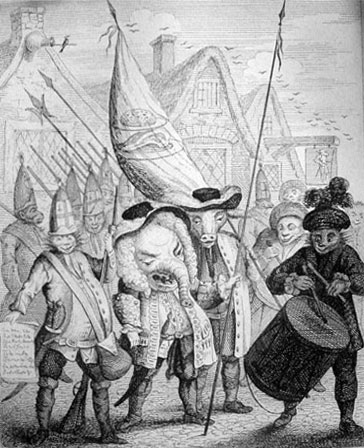
The City Trained Bands (1749)
 |
| Reproduced from the facsimile in Thomas Wright, Caricature History of the Georges. (London: John Camden Hotten, [1867]) 164. |
London's Trained Bands — the name given to the long-standing militia forces associated with the City — had long been the subject of satirical comment, dating back to the sixteenth century at least. This unattributed satirical print almost certainly refers to the panic created by the Jacobite rebellion of 1745-46, when "Bonnie Prince Charlie" (Charles Edward Stuart, the "Young Pretender") marched his Scottish forces into England, and appeared to be on the verge of threatening London itself.
The caricature, like most directed against the Trained Bands, makes its appeal to the class-snobbery of those who derided the citizens of London as "prentices" and "shopkeepers"; it particularly targets those who revelled absurdly in the pseudo-martial pretensions of the Trained Bands. Led by a pompous officer, here imagined as an elephant, the soldiers are shown "beating up recruits," and calling their rag-tag fellow citizens to arms. One of the soldiers (who appears as a cat) carries a proclamation that reads:
Come, taylors and weavers,
And sly penny shavers,
All haste and repair
To the Hog in Rag Fair,
To 'list in the pay
Of great Captain Day,
And you shall have cheer,
Beef, pudding, and beer.
The device on the flag carried by another of the soldiers (of indeterminate species) features an emblem of English "roast beef" and "plum pudding," and mocks the home-spun partriotism of the London "cits."
Beneath the print in the original were the following verses:
Hark, now the drum assaults our ears,
Thus beating up for volunteers;
Who fight, besiege, and storm amain,
And yet are never hurt or slain.
Sad work! should this tame army meet
The late pacific Spithead fleet.
(The reference in the last line is to a recent futile naval expedition which had returned to the main British naval base at Spithead after an uneventful foray onto the high seas).
 |
Website maintained by: Mark
McDayter
Website administrator: Mark McDayter
Last updated: April 25, 2002